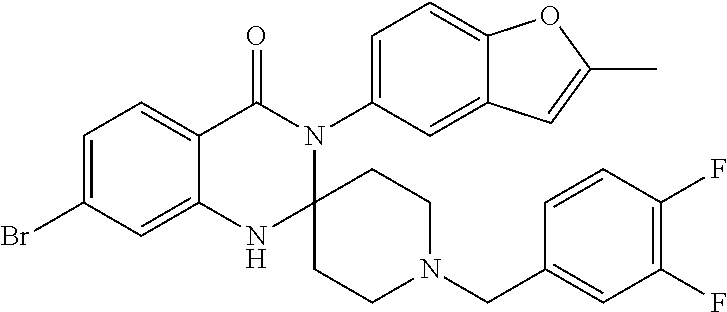Spiro-quinazolinone derivatives and their use as positive allosteric modulators of mGluR4
a technology of positive allosteric modulators and derivatives, which is applied in the field of spiroquinazolinone derivatives, can solve the problems of deteriorating patient and family quality of life, chronic administration is associated with serious side effects, and imbalance in glutamatergic neurotransmission
- Summary
- Abstract
- Description
- Claims
- Application Information
AI Technical Summary
Benefits of technology
Problems solved by technology
Method used
Image
Examples
example 1
Synthesis of Compound 66 (3′-(4-Methoxyphenyl)-1-(2-(trifluoromethyl)benzyl)-1′H-spiro[piperidine-4,2′-quinazolin]-4′(3′H)-one)
[0258]
[0259]Step 1: To a 500-mL round bottom flask with magnetic stir bar under a nitrogen atmosphere at 25° C. was added isatoic anhydride (10.0 g, 61.4 mmol) and anhydrous toluene (200 mL). The p-anisidine (7.9 g, 64.5 mmol) was added and the reaction vessel was heated at 100-105° C. for 6 h. The reaction temperature was subsequently reduced to 85° C. with stirring overnight. Upon completion the material was purified via silica gel column using ethyl acetate / dichloromethane as the eluent to give 2-amino-N-(4-methoxy-phenyl)-benzamide (9.59 g; 65%).
[0260]Step 2: To a 250-mL round bottom flask with magnetic stir bar under a nitrogen atmosphere at 25° C. was added 2-amino-N-(4-methoxy-phenyl)-benzamide (1.0 g, 4.17 mmol) and anhydrous toluene (20 mL). The 4-oxo-piperidine-1-carboxylic acid tert-butyl ester (0.83 g, 4.17 mmol) was added followed by toluene-4-s...
example 2
Synthesis of Compound 28 (1-Benzyl-7′-bromo-3′-(4-(trifluoromethoxy)phenyl)-1′H-spiro[piperidine-4,2′-quinazolin]-4′(3′H)-one)
[0285]
[0286]Step 1: To a 250-mL round bottom flask was added 2-amino-4-bromo-benzoic acid (2.5 g, 11.6 mmol) and anhydrous dimethyl formamide (45 mL). Triethylamine (4.8 mL, 34.7 mmol) was subsequently added followed by the di-tert-butyl dicarbonate (3.8 g, 17.4 mmol). The reaction mixture was stirred heated at 50° C. overnight. The reaction mixture was cooled to room temperature and poured into a flask containing water (150 mL). The resulting mixture was washed with ethyl acetate (2×10 mL). The aqueous phase was acidified to a pH range of 4-5 with 10% v / v aqueous HCl solution. The acidified mixture was extracted with dichloromethane (3×50 mL). The combined organic phase was washed with brine (15 mL), dried over anhydrous sodium sulfate, filtered, and evaporated in vacuo to give 4-bromo-2-tert-butoxycarbonylamino-benzoic acid (3.4 g; 94%) as beige solid.
[0287...
example 3
Synthesis of Compound 27 (7′-Bromo-1-(isoquinolin-5-ylmethyl)-3′-(4-(trifluoromethoxy)phenyl)-1′H-spiro[piperidine-4,2′-quinazolin]-4′(3′H)-one)
[0304]
[0305]Prepared following the same procedure as example 2 until step 4.
[0306]Step 5: To a 40 mL vial was added the tosylate salt of 7′-bromo-3′-(4-(trifluoromethoxy)phenyl)-1′H-spiro[piperidine-4,2′-quinazolin]-4′(3′H)-one (75 mg, 0.12 mmol) and anhydrous methanol (3 mL). Triethylamine (19 μL, 0.14 mmol) was added and the mixture stirred at 25° C. for 15 minutes. Glacial acetic acid (2 drops) was then added followed by isoquinoline-5-carbaldehyde (20 mg, 0.13 mmol) and drop-wise addition of sodium cyanoborohydride solution (1M in THF) (0.27 mL, 0.27 mmol). The reaction was stirred at 25° C. overnight. The reaction was diluted with ethyl acetate (10 mL). The resulting mixture was then added drop-wise to a dilute mixture (˜5% w / v) of aqueous sodium carbonate (10 mL). The layers were separated and the aqueous layer extracted with ethyl ace...
PUM
 Login to View More
Login to View More Abstract
Description
Claims
Application Information
 Login to View More
Login to View More - R&D
- Intellectual Property
- Life Sciences
- Materials
- Tech Scout
- Unparalleled Data Quality
- Higher Quality Content
- 60% Fewer Hallucinations
Browse by: Latest US Patents, China's latest patents, Technical Efficacy Thesaurus, Application Domain, Technology Topic, Popular Technical Reports.
© 2025 PatSnap. All rights reserved.Legal|Privacy policy|Modern Slavery Act Transparency Statement|Sitemap|About US| Contact US: help@patsnap.com



